Bell Food Group Bundle
How did a small Swiss butcher shop become a European food giant?
Journey back to 1869, when Samuel Bell-Roth laid the cornerstone for what would become the Bell Food Group. From a single butcher shop in Basel, Switzerland, this Swiss food company has evolved into a leading meat processing and convenience food producer across Europe. Discover how strategic decisions and market adaptations shaped the Bell Food Group SWOT Analysis.
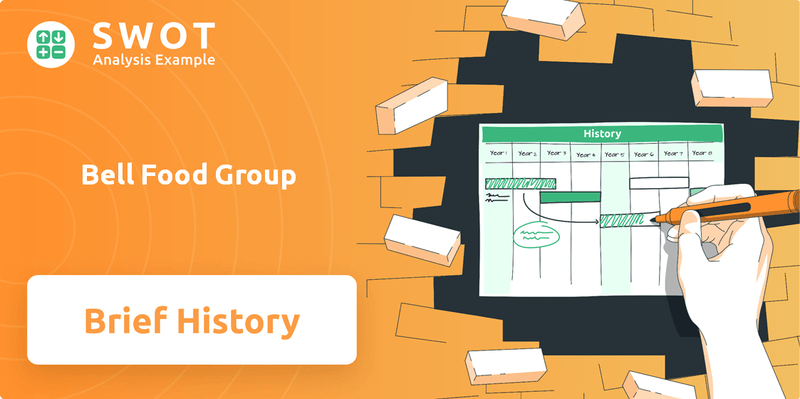
This brief history of Bell Food Group reveals a story of remarkable growth and adaptation. The company's expansion from 'Ochsenmetzg' to a diverse portfolio of products, including Bell Food Products, reflects its commitment to meeting evolving consumer needs. With a strong financial performance in 2024, Bell AG continues to solidify its position as a major player in the European food industry, making it a compelling case study for business strategists and investors alike.
What is the Bell Food Group Founding Story?
The history of the Swiss food company, Bell Food Group, began on March 29, 1869. This is when Samuel Bell-Roth launched his 'Ochsenmetzg' (ox butchery) at Streitgasse 13 in Basel, Switzerland. This marked the start of what would become a significant player in the meat processing industry.
Initially, the business was a traditional butcher's shop. It involved on-site slaughtering, processing, and retail sales. Samuel Bell-Roth's foresight drove him to expand beyond this model. This led to the establishment of a new production facility outside Basel.
To enhance their expertise, Samuel Bell-Roth sent his sons abroad to learn the charcuterie trade. This set the stage for future product diversification. In 1899, the company was formally established as Samuel Bell Söhne. This involved Samuel Bell-Roth, Eduard Bell, Samuel Bell-Vollenweider, and Rudolf Bell. This family-driven initiative aimed to professionalize and grow the meat processing business.
The company's transformation from a butcher shop to a large-scale enterprise is a story of strategic decisions and family involvement.
- 1869: Samuel Bell-Roth opens 'Ochsenmetzg' in Basel, marking the start of the business.
- 1899: The company is formalized as Samuel Bell Söhne, involving the Bell family.
- 1907: The company becomes a stock corporation and acquires land at Elsässerstrasse 174–188 in Basel, its current headquarters.
In 1907, the company transitioned into a stock corporation. Also in that year, it acquired land at Elsässerstrasse 174–188 in Basel. This location remains the company's headquarters and a key production site. This move was a major step from an artisan butcher's shop to a large-scale meat and charcuterie production enterprise. For more insights into the company's strategic development, consider reading about the Growth Strategy of Bell Food Group.
Bell Food Group SWOT Analysis
- Complete SWOT Breakdown
- Fully Customizable
- Editable in Excel & Word
- Professional Formatting
- Investor-Ready Format
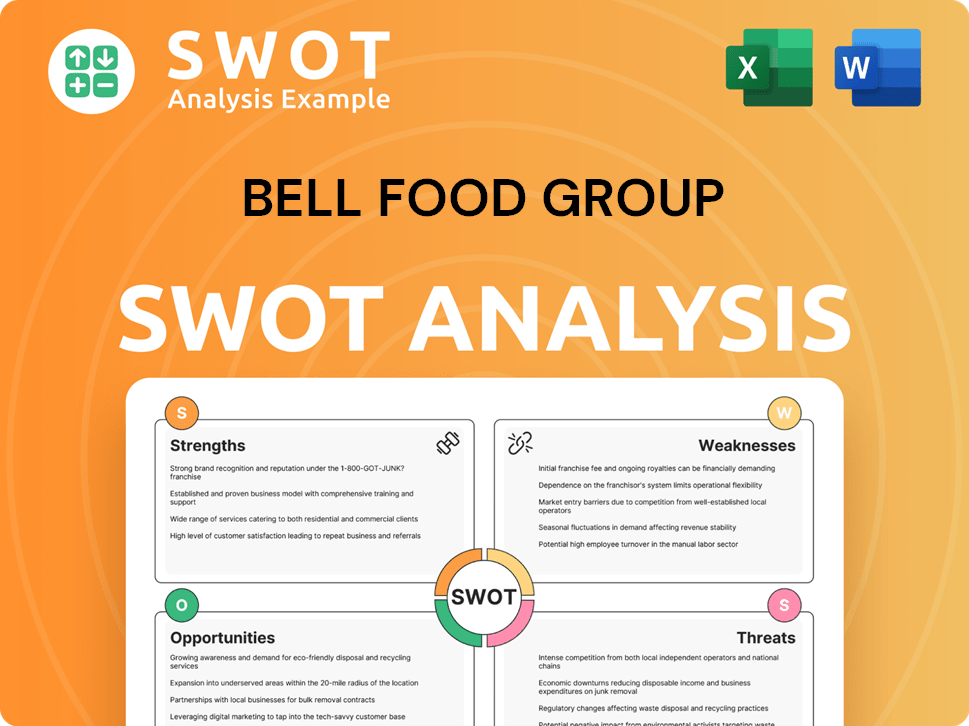
What Drove the Early Growth of Bell Food Group?
The early growth of the Bell Food Group was characterized by strategic expansion and a focus on market opportunities. By 1912, the company had already established itself as the largest meat producer in Switzerland. A key partnership in 1913 with the Association of Swiss Consumers (now Coop) significantly bolstered its market presence.
The company expanded its retail footprint, reaching a peak of 172 sales outlets across Switzerland by 1962. This expansion solidified its position as a leading meat and sausage company in the region. This growth phase was critical in establishing Bell AG's dominance in the Swiss market.
In 1969, coinciding with its centenary, Bell made its first significant acquisition with Grieder AG. The late 1990s saw an acceleration of acquisitions, including Vuillamy SA in 1997 and SEG-Poulet AG in 1998. These moves expanded expertise and ventured into promising business areas.
International expansion began in 2006 with meat exports to Luxembourg, followed by acquisitions in France and Germany. In 2008, Bell AG acquired stakes in German meat product manufacturers, including Zimbo and Abraham Schinken. These strategic moves transformed Bell Food Group into an internationally oriented specialist for fresh food.
The group of companies was converted into a holding company in 1999. In 2001, Bell took over all Coop butchers' headquarters. By 2004, Bell spun off its own butcher shops, focusing entirely on production. This restructuring allowed for a more streamlined and focused approach to its core business.
Bell Food Group PESTLE Analysis
- Covers All 6 PESTLE Categories
- No Research Needed – Save Hours of Work
- Built by Experts, Trusted by Consultants
- Instant Download, Ready to Use
- 100% Editable, Fully Customizable
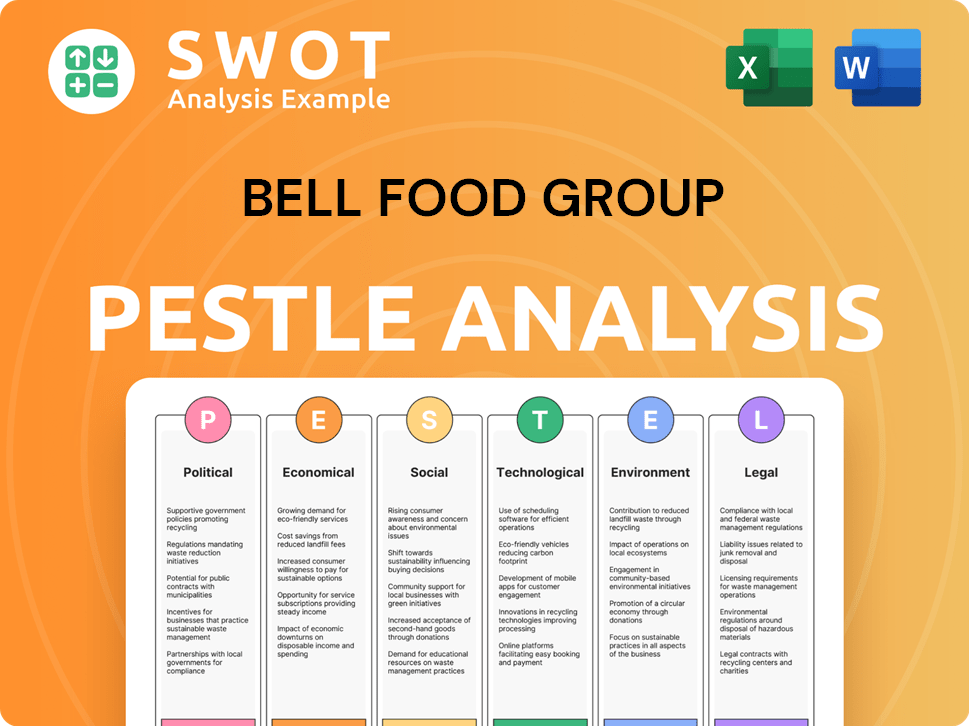
What are the key Milestones in Bell Food Group history?
The Marketing Strategy of Bell Food Group has been marked by significant milestones, strategic acquisitions, and a commitment to innovation. Bell Food Group, a prominent Swiss food company, has navigated its history by adapting to market changes and consumer preferences. The company's journey includes pioneering technological advancements and responding to challenges in the meat processing sector.
| Year | Milestone |
|---|---|
| 2005 | Implementation of an RFID-controlled high-bay storage facility in Oensingen, Switzerland, a pioneering move in the meat industry. |
| 2018 | Acquisition of a controlling stake in Hügli, a Swiss soup and sauce producer, integrating it as an independent business unit. |
| 2018 | Investment of €2 million in Mosa Meat, a Dutch company focused on cultivated meat, showing early interest in alternative protein sources. |
| 2021 | Acquisition of Hofmetzgerei F. Hölzle GmbH, entering the organic meat sector. |
| 2022 | Acquisition of Stockli hatchery for poultry production. |
| 2023 | Plant-based options accounted for 15% of total sales in the first half of 2023. |
| 2025 | Bell Food Group's Eisberg unit announced the sale of three production sites in Poland, Romania, and Hungary to Green Factory in May 2025, to concentrate on core markets in the DACH region. |
Bell Food Group was an early adopter of advanced technologies, such as the RFID-controlled high-bay storage facility, which was a significant innovation in the meat processing industry. This early adoption of technology set a precedent for efficiency and operational excellence.
The company consistently invests in research and development, with an annual R&D expenditure of approximately CHF 15 million as of 2023. This investment has led to the launch of new product lines, including plant-based options.
Bell Food Group has expanded its product offerings to include plant-based alternatives. In the first half of 2023, these options accounted for 15% of total sales, reflecting a strategic response to changing consumer preferences.
In 2022, Bell Food Group allocated around €22 million to R&D, focusing on sustainability practices and eco-friendly packaging solutions. This focus demonstrates a commitment to environmentally responsible operations.
In 2018, Bell acquired a controlling stake in Hügli, a Swiss soup and sauce producer, integrating it as an independent business unit. This acquisition expanded Bell's product range and market reach.
Bell invested in Mosa Meat, a Dutch company focused on cultivated meat, demonstrating an early interest in alternative protein sources. This investment highlights the company's forward-thinking approach to food technology.
Bell Food Group has adapted to evolving consumer sentiment, which has led to a shift in demand towards lower-priced product ranges. This requires the company to adjust its product offerings and pricing strategies.
Market downturns and competitive pressures are ongoing concerns for Bell Food Group. The company must continually innovate and optimize operations to maintain its market position.
The procurement situation for raw materials can be challenging due to factors like adverse weather conditions. This requires careful supply chain management and risk mitigation strategies.
Bell Food Group's Eisberg unit announced the sale of three production sites in Poland, Romania, and Hungary to Green Factory in May 2025, to concentrate on core markets in the DACH region. This strategic realignment demonstrates the company's adaptability in optimizing operations.
The company faced an occupation of its Oensingen slaughterhouse by animal rights activists in 2018. This highlights the need for ongoing dialogue and transparency regarding animal welfare practices.
Bell Food Group addresses challenges through continuous modernization, strategic investments in new facilities, and a focus on operational efficiency. This helps the company to remain competitive and sustainable.
Bell Food Group Business Model Canvas
- Complete 9-Block Business Model Canvas
- Effortlessly Communicate Your Business Strategy
- Investor-Ready BMC Format
- 100% Editable and Customizable
- Clear and Structured Layout
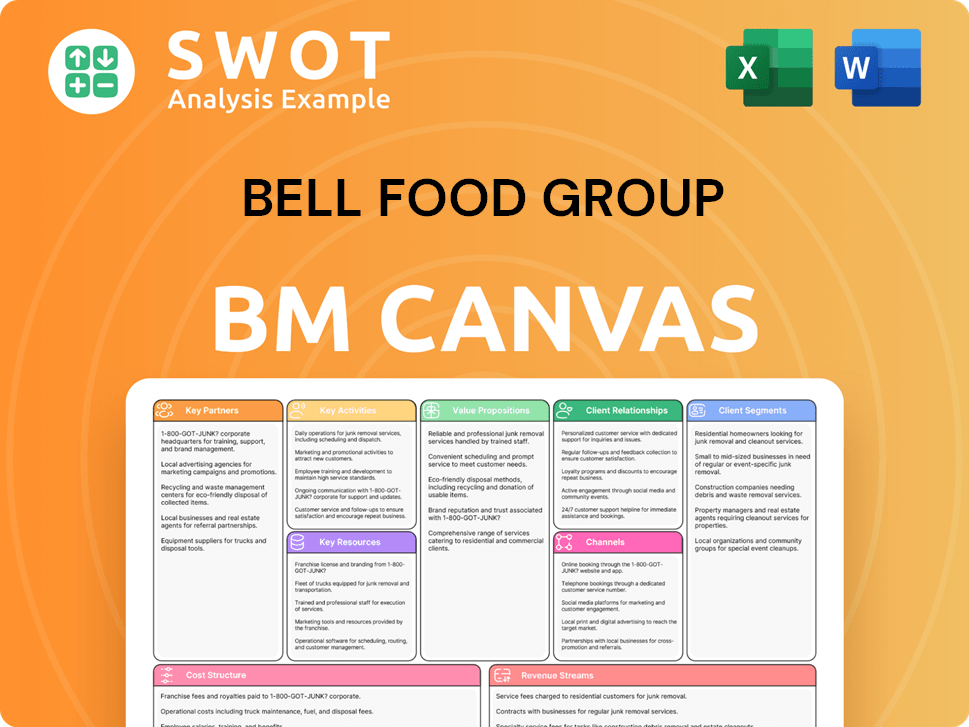
What is the Timeline of Key Events for Bell Food Group?
The brief history of Bell Food Group shows its evolution from a small butcher shop to a major Swiss food company. The company's journey is marked by strategic acquisitions, expansions into new markets, and a focus on innovation and sustainability, reflecting its commitment to providing high-quality food products.
| Year | Key Event |
|---|---|
| 1869 | Samuel Bell-Roth opens 'Ochsenmetzg' in Basel, Switzerland. |
| 1899 | Samuel Bell Söhne is founded by Samuel Bell-Roth and his sons. |
| 1907 | The company becomes a stock corporation and acquires its current headquarters in Basel. |
| 1912 | Bell becomes the largest meat producer in Switzerland. |
| 1913 | Formation of the 'Bell Alliance' with the Association of Swiss Consumers (now Coop). |
| 1969 | Acquisition of Grieder AG in Oensingen. |
| 1997 | Acquisition of Vuillamy SA, a charcuterie company. |
| 1998 | Entry into the poultry business with the purchase of SEG-Poulet AG. |
| 1999 | Conversion of the group of companies into a holding company. |
| 2004 | Bell spins off its own butcher shops to focus on production. |
| 2006 | Bell enters foreign markets, including Luxembourg, France (Polette), and Germany (Abraham). |
| 2008 | Acquisition of stakes in Zimbo and Abraham Schinken in Germany. |
| 2016 | Acquisition of Hubers, Austria's largest poultry producer. |
| 2017 | Bell Group is renamed Bell Food Group, reflecting its broader focus. |
| 2018 | Acquisition of a controlling stake in Hügli and investment in Mosa Meat. |
| 2021 | Acquisition of Hofmetzgerei F. Hölzle GmbH, expanding into organic meat. |
| 2022 | Acquisition of Stockli hatchery. |
| 2024 | Reports group net revenue of CHF 4.73 billion (US$5.23 billion) and EBITDA of CHF 351 million. |
| May 2025 | Eisberg (Bell Food Group unit) sells production sites in Poland, Romania, and Hungary to Green Factory to focus on DACH region. |
Bell Food Group's strategy for 2021-2025 centers on strengthening its core business within the meat processing sector and implementing innovative solutions for retail and food service. This includes continuous modernization and investment in new facilities.
The company is actively constructing new facilities in Oensingen, Switzerland, including a cattle slaughterhouse and logistics center, scheduled for commission in 2025. Bell Food Group aims to boost revenue by €150 million from ready-to-eat meals by 2025.
Sustainability is a key focus, with initiatives including responsible sourcing and waste reduction. Bell Food Group is committed to aligning with Samuel Bell's original vision, emphasizing high-quality food with a focus on sustainability and innovation.
Analysts project Bell Food Group's earnings per share (EPS) to increase by 3.2% annually over the next three years. Despite market volatility, the company is well-positioned for the future, focusing on both organic growth and strategic acquisitions within the Swiss food company.
Bell Food Group Porter's Five Forces Analysis
- Covers All 5 Competitive Forces in Detail
- Structured for Consultants, Students, and Founders
- 100% Editable in Microsoft Word & Excel
- Instant Digital Download – Use Immediately
- Compatible with Mac & PC – Fully Unlocked
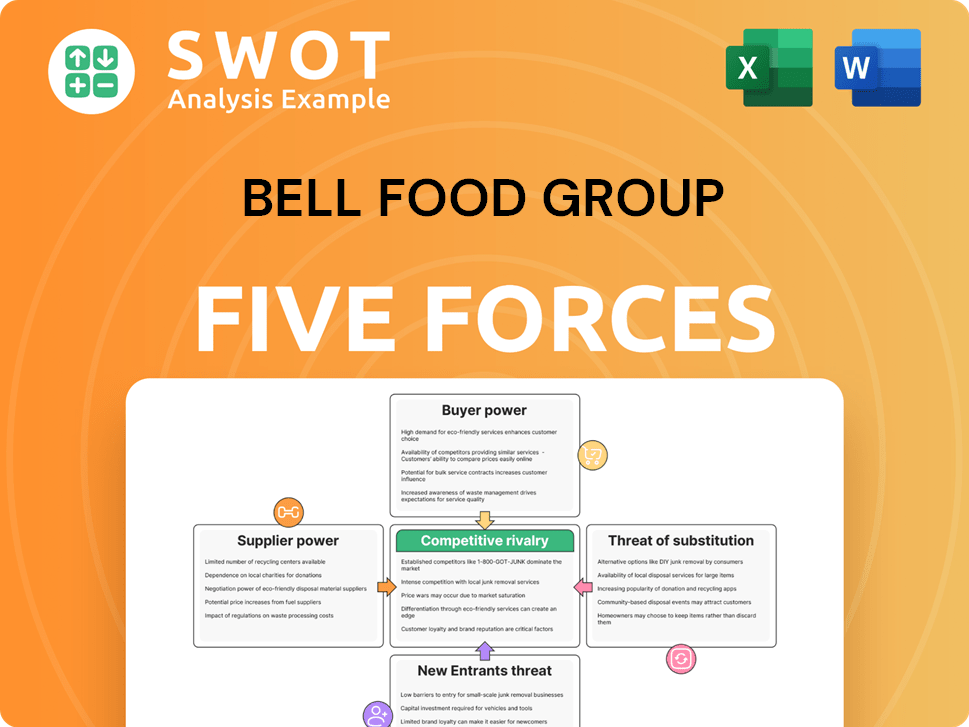
Related Blogs
- What is Competitive Landscape of Bell Food Group Company?
- What is Growth Strategy and Future Prospects of Bell Food Group Company?
- How Does Bell Food Group Company Work?
- What is Sales and Marketing Strategy of Bell Food Group Company?
- What is Brief History of Bell Food Group Company?
- Who Owns Bell Food Group Company?
- What is Customer Demographics and Target Market of Bell Food Group Company?
Disclaimer
All information, articles, and product details provided on this website are for general informational and educational purposes only. We do not claim any ownership over, nor do we intend to infringe upon, any trademarks, copyrights, logos, brand names, or other intellectual property mentioned or depicted on this site. Such intellectual property remains the property of its respective owners, and any references here are made solely for identification or informational purposes, without implying any affiliation, endorsement, or partnership.
We make no representations or warranties, express or implied, regarding the accuracy, completeness, or suitability of any content or products presented. Nothing on this website should be construed as legal, tax, investment, financial, medical, or other professional advice. In addition, no part of this site—including articles or product references—constitutes a solicitation, recommendation, endorsement, advertisement, or offer to buy or sell any securities, franchises, or other financial instruments, particularly in jurisdictions where such activity would be unlawful.
All content is of a general nature and may not address the specific circumstances of any individual or entity. It is not a substitute for professional advice or services. Any actions you take based on the information provided here are strictly at your own risk. You accept full responsibility for any decisions or outcomes arising from your use of this website and agree to release us from any liability in connection with your use of, or reliance upon, the content or products found herein.